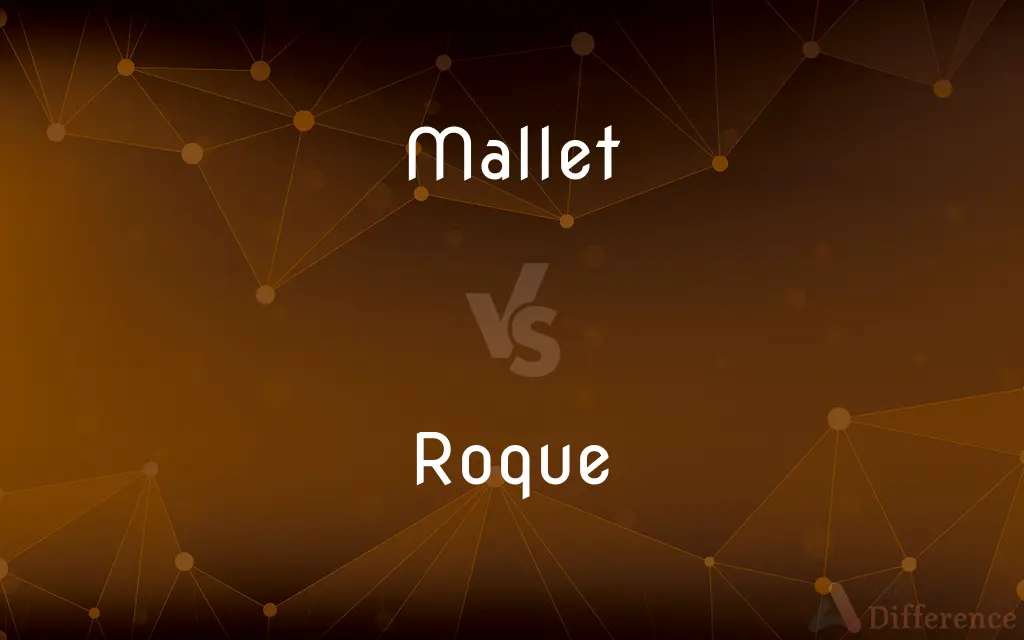Mallet vs. Roque — What's the Difference?
Edited by Tayyaba Rehman — By Urooj Arif — Updated on April 23, 2024
Mallets are tools with large, typically wooden heads used for striking, while roque is a game resembling croquet played on a hard, smooth surface.

Difference Between Mallet and Roque
Table of Contents
ADVERTISEMENT
Key Differences
Mallets are designed with a large head to distribute force over a wide area, ideal for woodworking or upholstery tasks. In contrast, roque involves precision in striking balls with mallets, focusing on accuracy rather than force.
A typical mallet head is made of wood, rubber, or sometimes leather, suited to tasks that require non-marring strikes. Meanwhile, roque mallets are specifically crafted to be durable and capable of withstanding repeated impacts on hard surfaces.
Mallets come in various sizes and weights to suit different applications, from delicate jewelry making to robust carpentry. On the other hand, roque mallets are standardized in size and weight to ensure fairness and uniformity in gameplay.
In use, mallets may be wielded in various industries, including construction, woodworking, and metalwork, each type designed for specific tasks. Conversely, roque is strictly a competitive or recreational sport, with mallets used exclusively within this context.
The technique of using a mallet can vary significantly depending on the application, from gentle taps to forceful swings. However, in roque, the technique is finely honed to control the direction and distance of ball movement with precision strikes.
ADVERTISEMENT
Comparison Chart
Primary Use
Striking tools for various tasks
A sport similar to croquet
Material
Wood, rubber, or leather
Hard materials, often wood or metal
Size Variation
Available in various sizes
Standardized size
Usage Context
Industry, craft, construction
Competitive and recreational sport
Technique
Depends on the task
Precision striking for gameplay
Compare with Definitions
Mallet
Used in a variety of applications from carpentry to tent pegging.
She grabbed a mallet to secure the tent pegs into the ground.
Roque
Played on a smaller, bounded court compared to traditional croquet.
The roque court was set up with tight boundaries for challenging gameplay.
Mallet
Often made of wood or rubber to minimize damage on the struck surface.
The carpenter picked up a wooden mallet to tap the chisels.
Roque
Often involves tactical positioning and thoughtful planning.
His next move in the roque game was critical for setting up a potential win.
Mallet
Different sizes cater to specific tasks, from delicate to robust.
The jeweler used a small mallet to carefully set the gemstones.
Roque
An American version of croquet played on a hard, smooth court.
They played roque under the bright afternoon sun.
Mallet
Mallets distribute force evenly to avoid damaging delicate materials.
A rubber mallet was ideal for assembling the furniture without scratches.
Roque
The game requires precision and control with specialized equipment.
Accurate strikes in roque are crucial for winning.
Mallet
A tool with a heavy head on a sturdy handle used for hitting.
He used a mallet to shape the leather in the workshop.
Roque
Uses balls, mallets, and wickets, focusing on skill and strategy.
Strategic placement of his ball made him a formidable roque player.
Mallet
A mallet is a kind of hammer, often made of rubber or sometimes wood, that is smaller than a maul or beetle, and usually has a relatively large head. The term is descriptive of the overall size and proportions of the tool, and not the materials it may be made of, though most mallets have striking faces that are softer than steel.
Roque
Roque is an American variant of croquet played on a hard, smooth surface. Popular in the first quarter of the 20th century and billed "the Game of the Century" by its enthusiasts, it was an Olympic sport in the 1904 Summer Games, replacing croquet from the previous games.
Mallet
A short-handled hammer, usually with a cylindrical head of wood, used chiefly to drive a chisel or wedge.
Roque
A variation of croquet played with short-handled mallets on a hard court that is bounded by a concrete wall against which a ball may rebound and be retrieved.
Mallet
A similar tool with a rubber, leather, or plastic head, used to strike a surface without damaging it.
Roque
(US) a form of croquet using short-handled mallets, and played on a hard surface
Mallet
(Sports) A long-handled implement used to strike a ball, as in croquet and polo.
Roque
A form of croquet modified for greater accuracy of play. The court has a wood border often faced with rubber, used as a cushion in bank shots. The balls are 3¼ in. in diameter, the cage (center arches or wickets) 3
Mallet
(Music) A light hammer with a rounded head for striking a percussion instrument.
Mallet
A type of hammer with a larger-than-usual head made of wood, rubber or similar non-iron material, used by woodworkers for driving a tool, such as a chisel. A kind of maul.
Carpenters use mallets for assembling.
We used a mallet to drive the tent pegs into the ground.
Mallet
(weapons) A weapon resembling the tool, but typically much larger.
Mallet
(music) A small hammer-like tool used for playing certain musical instruments.
Mallet
(games) A light beetle with a long handle used in playing croquet.
Mallet
(sports) The stick used to strike the ball in the sport of polo.
Mallet
(transitive) To beat or strike with, or as if with, a mallet.
Mallet
A small maul with a short handle, - used esp. for driving a tool, as a chisel or the like; also, a light beetle with a long handle, - used in playing croquet.
Mallet
A sports implement with a long handle and a head like a hammer; used in sports (polo or croquet) to hit a ball
Mallet
A light drumstick with a rounded head that is used to strike percussion instruments
Mallet
A tool resembling a hammer but with a large head (usually wooden); used to drive wedges or ram down paving stones or for crushing or beating or flattening or smoothing
Common Curiosities
What are the key skills needed for roque?
Precision, strategic thinking, and good control over mallet strikes are essential for roque.
What are the dimensions of a typical roque court?
A roque court is typically about 30 by 60 feet.
How does roque differ from croquet?
Roque is played on a hard, smooth surface and has a smaller playing area, emphasizing more skill and accuracy.
What materials are mallets made from?
Mallets are typically made from wood, rubber, or leather.
Is roque a team sport?
Roque can be played both individually and in teams, depending on the game format.
What is a mallet used for?
Mallets are used for striking or hitting tasks in various industries, ensuring gentle impact on surfaces.
Where is roque commonly played?
Roque is mainly played in the United States.
Can a regular mallet be used for roque?
No, roque requires specially designed mallets that can withstand hard surfaces.
How long does a typical game of roque last?
The length can vary, but a game of roque usually lasts around one to two hours.
Can mallets be used for purposes other than striking?
While primarily used for striking, mallets can also be used for shaping soft materials.
How do players score in roque?
Players score by hitting balls through wickets, similar to croquet.
What is the best strategy for winning at roque?
Mastering precise strikes and strategically planning ball placement are key strategies.
Are there different types of mallets?
Yes, there are several types of mallets, each designed for specific tasks, such as carpentry, upholstery, or metalwork.
What is the ideal weight for a carpentry mallet?
The ideal weight varies, but it is generally between 1 and 2 pounds for precision work.
Are there professional roque tournaments?
Yes, there are professional roque tournaments, particularly in regions where the game is popular.
Share Your Discovery

Previous Comparison
Immediately vs. Immediate
Next Comparison
Mohel vs. IzmelAuthor Spotlight
Written by
Urooj ArifUrooj is a skilled content writer at Ask Difference, known for her exceptional ability to simplify complex topics into engaging and informative content. With a passion for research and a flair for clear, concise writing, she consistently delivers articles that resonate with our diverse audience.
Edited by
Tayyaba RehmanTayyaba Rehman is a distinguished writer, currently serving as a primary contributor to askdifference.com. As a researcher in semantics and etymology, Tayyaba's passion for the complexity of languages and their distinctions has found a perfect home on the platform. Tayyaba delves into the intricacies of language, distinguishing between commonly confused words and phrases, thereby providing clarity for readers worldwide.
















































